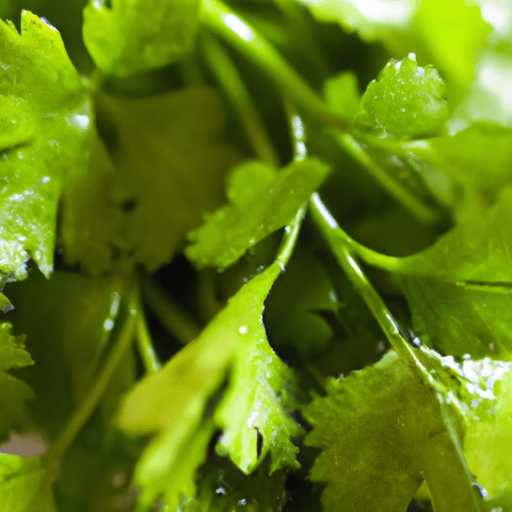The Fresh and Fragrant Herb: Cilantro
If you have ever ventured into the realm of Mexican, Indian, or Thai cuisine, you may have encountered the vibrant herb known as cilantro. With its distinctive aroma and fresh, citrusy flavor, cilantro has become a staple in kitchens around the world. In this blog post, we will dive deep into all things cilantro, from its taste and common uses in cooking to its nutritional benefits and interesting historical tidbits.
Taste and Aroma
Cilantro, also referred to as coriander leaves or Chinese parsley, delivers a unique flavor profile that can be polarizing. Some people find it refreshing and zesty, while others detect an overpowering soapy taste. This taste variation is due to a genetic predisposition, making cilantro a “love it or hate it” herb.
The herb’s aroma is equally distinctive, characterized by a strong, citrusy scent with hints of pepper and earthiness. This aromatic quality enhances the overall sensory experience when using cilantro in cooking.
Common Uses in Cooking
Cilantro is an incredibly versatile herb that adds a vibrant touch to countless dishes. It is commonly used in both fresh and cooked forms, allowing for a range of culinary possibilities. Some popular uses of cilantro include:
Salsas and Dips: Cilantro plays a starring role in classic salsas, guacamole, and chutneys, adding a fresh and herbaceous quality that balances the richness of other ingredients.
Soups and Curries: Whether it’s a hearty tomato-based soup or a fragrant Indian curry, cilantro can be used as a garnish or stirred into the pot towards the end of cooking to infuse a burst of flavor.
Salads and Dressings: Chopped cilantro can elevate salads with its bold aroma and a hint of tanginess. It also pairs well with lime juice, making it a fantastic addition to homemade dressings and marinades.
Marinades and Rubs: For those who crave a punch of flavor, cilantro can be blended into marinades for grilled meats or incorporated into spice rubs to add a refreshing twist.
Nutritional Value
Beyond its culinary attributes, cilantro boasts an impressive nutritional profile. It is packed with vitamins, minerals, and antioxidants, making it a valuable addition to any diet. Here are some key nutritional benefits of cilantro:
- Vitamin A: Cilantro is rich in vitamin A, essential for healthy vision and immune function.
- Vitamin C: With its high vitamin C content, cilantro provides a natural immune system boost and promotes collagen production for healthy skin.
- Dietary Fiber: Cilantro is a good source of dietary fiber, aiding digestion and promoting a healthy gut.
- Minerals: Cilantro contains minerals like potassium, calcium, and iron, which contribute to overall well-being.
History and Interesting Facts
Cilantro has a fascinating history that dates back thousands of years. It is believed to have originated in the eastern Mediterranean region and was subsequently introduced to various parts of the world by early explorers and traders. This herb has been a culinary favorite in Asian, African, and Latin American cuisines for centuries.
Interestingly, cilantro has also found a place in traditional medicine. Ancient cultures believed it possessed healing properties and used it to treat ailments such as indigestion and urinary tract infections.
It is worth noting that cilantro is not only valued for its vibrant leaves but also for its seeds, known as coriander. These seeds boast a delightful warm and lemony flavor, adding depth to countless dishes, spice blends, and even craft cocktails.
Wrapping Up
Cilantro is much more than a simple herb - it is a culinary superstar that can elevate dishes with its distinctive taste and aroma. Whether you add it to your favorite salsa, curry, or salad, cilantro is sure to leave a lasting impression on your taste buds. So, embrace its unique qualities and experiment with this versatile herb to unlock new dimensions of flavor in your cooking adventures.
Cilantro
- Origin: Cilantro, also known as coriander or Chinese parsley, is believed to have originated in the Mediterranean region and is now widely cultivated and used in many cuisines around the world.
- Common Uses: Cilantro is a versatile herb that is used in various cuisines, including Mexican, Indian, Middle Eastern, and Southeast Asian. It is commonly used in salsa, guacamole, curry, stir-fries, salads, and as a garnish for soups and stews.
- Nutritional Benefits: Cilantro is a good source of vitamins A, C, and K. It also contains small amounts of minerals such as potassium, calcium, and magnesium. Additionally, cilantro provides dietary fiber and antioxidants.
- Unique Properties: Cilantro has a distinct flavor characterized as fresh, citrusy, and slightly peppery. It is known for its strong aroma. Some people have a genetic predisposition that causes them to perceive cilantro as having a soapy or unpleasant taste.
- Historical Significance: Cilantro has been used for centuries and has historical significance in various cultures. Ancient Egyptians used cilantro in their medicinal preparations, while ancient Greeks and Romans used it as a perfuming herb. In Indian and Ayurvedic traditions, cilantro has been used as a digestive aid. It plays an important role in Mexican and Vietnamese cuisines, as well as being a staple herb in many other cultures around the world.




Use the share button below if you liked it.
It makes me smile, when I see it.